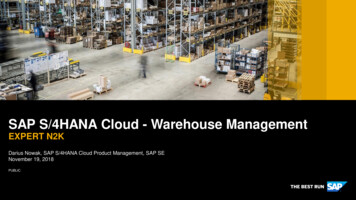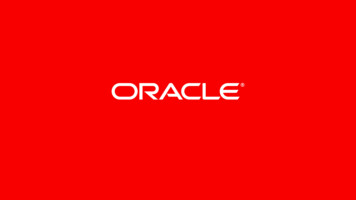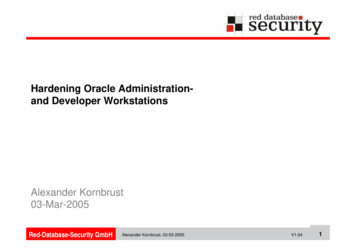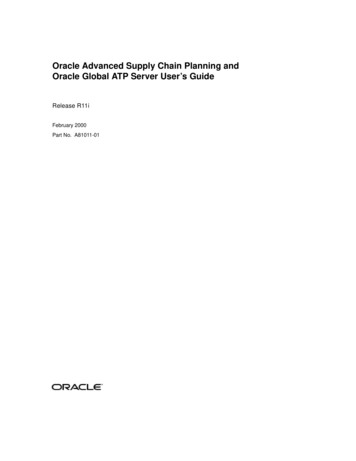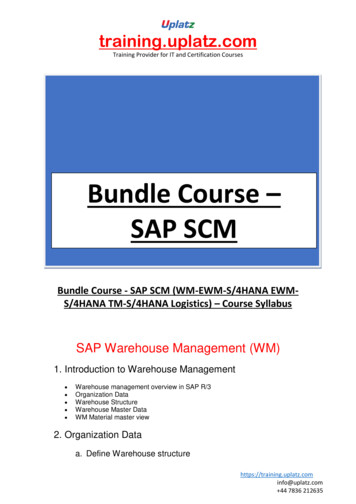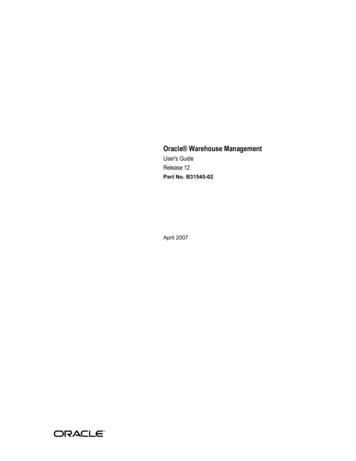
Transcription
Oracle Warehouse ManagementUser's GuideRelease 12Part No. B31545-02April 2007
Oracle Warehouse Management User's Guide, Release 12Part No. B31545-02Copyright 1994, 2007, Oracle. All rights reserved.Primary Author:Tyra CrockettThe Programs (which include both the software and documentation) contain proprietary information; theyare provided under a license agreement containing restrictions on use and disclosure and are also protectedby copyright, patent, and other intellectual and industrial property laws. Reverse engineering, disassembly, ordecompilation of the Programs, except to the extent required to obtain interoperability with otherindependently created software or as specified by law, is prohibited.The information contained in this document is subject to change without notice. If you find any problems inthe documentation, please report them to us in writing. This document is not warranted to be error-free.Except as may be expressly permitted in your license agreement for these Programs, no part of thesePrograms may be reproduced or transmitted in any form or by any means, electronic or mechanical, for anypurpose.If the Programs are delivered to the United States Government or anyone licensing or using the Programs onbehalf of the United States Government, the following notice is applicable:U.S. GOVERNMENT RIGHTSPrograms, software, databases, and related documentation and technical data delivered to U.S. Governmentcustomers are "commercial computer software" or "commercial technical data" pursuant to the applicableFederal Acquisition Regulation and agency-specific supplemental regulations. As such, use, duplication,disclosure, modification, and adaptation of the Programs, including documentation and technical data, shallbe subject to the licensing restrictions set forth in the applicable Oracle license agreement, and, to the extentapplicable, the additional rights set forth in FAR 52.227-19, Commercial Computer Software--RestrictedRights (June 1987). Oracle Corporation, 500 Oracle Parkway, Redwood City, CA 94065.The Programs are not intended for use in any nuclear, aviation, mass transit, medical, or other inherentlydangerous applications. It shall be the licensee's responsibility to take all appropriate fail-safe, backup,redundancy and other measures to ensure the safe use of such applications if the Programs are used for suchpurposes, and we disclaim liability for any damages caused by such use of the Programs.The Programs may provide links to Web sites and access to content, products, and services from third parties.Oracle is not responsible for the availability of, or any content provided on, third-party Web sites. You bear allrisks associated with the use of such content. If you choose to purchase any products or services from a thirdparty, the relationship is directly between you and the third party. Oracle is not responsible for: (a) the qualityof third-party products or services; or (b) fulfilling any of the terms of the agreement with the third party,including delivery of products or services and warranty obligations related to purchased products or services.Oracle is not responsible for any loss or damage of any sort that you may incur from dealing with any thirdparty.Oracle, JD Edwards, PeopleSoft, and Siebel are registered trademarks of Oracle Corporation and/or itsaffiliates. Other names may be trademarks of their respective owners.
ContentsSend Us Your CommentsPreface1Oracle Warehouse Management OverviewOverview of the Oracle Warehouse Management System.1-1Inbound Logistics. 1-4Inventory, Storage, and Facility Management. 1-4Oracle Warehouse Management Value Added Services. 1-6Outbound Logistics. 1-6Reverse Logistics. 1-7Warehouse Configuration. 1-8Container and License Plate Management. 1-8Oracle Warehouse Management Rules Engine. 1-92Oracle Warehouse Management Rules EngineOverview of the Rules Engine. 2-1Components of the Rules Engine.2-5Overview of Rules Setup. 2-7The Rules Window. 2-8Task Type, Label Format, and Operation Plan Selection Rules.2-13Picking Rule Allocation. 2-13Process Allocation Logic. 2-17Picking Rules for Oracle Warehouse Management Enabled Project ManufacturingOrganizations. 2-18Setting Up Pick Wave Rules. 2-20iii
Oracle Warehouse Management Strategies Window. 2-22Rules Workbench. 2-23Explaining the Oracle Warehouse Management Rules Engine Simulator. 2-27Summary of Rule Properties. 2-353Material ManagementExplaining License Plate Management. 3-1Explaining Multi-level Nesting Support. 3-2Viewing LPNs. 3-2Generating License Plate Numbers. 3-5Maintaining LPNs. 3-8Performing Inventory Transactions with LPNs. 3-10Lot Transactions. 3-15How to Split a Lot. 3-18How to Merge a Lot. 3-21How to Translate a Lot. 3-23Viewing Lots. 3-25Explaining How to Use Oracle Warehouse Management Kanban Management Features. 3-26Explaining LPN Based WIP Completions and Put Away. 3-27Describing WIP Completions within Oracle Warehouse Management. 3-27Explaining Prepacking LPNs for WIP Completions. 3-29Describing Oracle Warehouse Management Inquiry Windows. 3-31Mobile Inquiries . 3-32Locator Alias. 3-38Consigned Stock and Vendor Managed Inventory in Oracle Warehouse Management. 3-414Task ManagementOverview of Task Planning. 4-2Set up Operation Plans. 4-2Setup Task Filters. 4-7Explaining Task Dispatch and Assignment. 4-7Explaining Task Unloading. 4-12Explaining Task Skipping. 4-13Task Exceptions. 4-14Explaining the Warehouse Control Board. 4-15Navigating the Warehouse Control Board. 4-16Managing Tasks. 4-25Using the Oracle Warehouse Management Control Board for Task Planning.4-28Using the Oracle Warehouse Management Control Board for Outbound Operations. 4-29Using the Oracle Warehouse Management Control Board for Inbound Operations.4-32iv
Using the Oracle Warehouse Management Control Board for Manufacturing Operations. 4-33Using the Oracle Warehouse Management Control Board for Warehousing Operations. 4-34Performing Rough Cut Planning. 4-34Using the Warehouse Control Board as a Monitoring Tool. 4-36How to Perform Task Dispatched Cycle Counts. 4-365Oracle Warehouse Management Inbound LogisticsInbound Logistics Overview. 5-2Oracle Warehouse Management Inbound Features. 5-4Describing Receiving Documents.5-5Describing Receiving Methods. 5-6Explaining the Standard Receipt Process. 5-8Explaining the Direct Receipt Process. 5-10Explaining the Confirm Receipt Process. 5-11Explaining the Express Receipt Process Using ASNs.5-13Explaining the Inspection Process. 5-14How to Perform Receiving Transactions Using the Oracle Warehouse Management MobileUser Interface. 5-15How to Perform an ASN Receipt. 5-25How to Print the ASN Discrepancy Report. 5-26Explaining the Express Receipt Process Using Internal Requisitions. 5-28Explaining the Express Receipt Process Using Internal Shipments. 5-29Receiving Common User Interface. 5-30Receiving for Different Routings. 5-30Receiving Material Sent for Outside Processing. 5-30Displaying Country Of Origin. 5-31Displaying Routing Message. 5-31How to Perform Receipts Using the Receiving Common Interface.5-32Document Initiated Receipts.5-33Item Initiated Receipts. 5-35Cross References for Vendor Items. 5-35Describing the LPN Put Away Process. 5-36Multi-Step Putaway and Replenishment. 5-41Explaining LPN Based Returns. 5-42LPN Transactions. 5-45Explaining Pre-Generated Putaways. 5-606Oracle Warehouse Management CrossdockingOverview of Crossdocking. 6-1v
Planned Crossdocking. 6-2Opportunistic Crossdocking. 6-5Opportunistic Crossdock Receipt Validations. 6-7Crossdocking and Change Management. 6-7Crossdocking Exceptions. 6-11Crossdocking Criteria. 6-13Crossdock Execution. 6-187Oracle Warehouse Management Outbound LogisticsOverview of the Material Picking Process.7-1Explaining Pick Release. 7-2Explaining the Pick Allocation Process. 7-2Explaining the Picking Process. 7-2Explaining Pick Task Grouping. 7-4Describing Pick Methodologies. 7-4Performing Picks. 7-8Bulk Picking. 7-12Explaining Over Picking. 7-17Under Picking Without Exception. 7-19Describing Task Loading and Dropping. 7-19Pick Load Setup. 7-20Explaining Express Load. 7-28Explaining Express Picking. 7-30How to Perform Move Order Transactions. 7-33Explaining Oracle Warehouse Management Picking for Manufacturing. 7-358Label Printing and Material Handling EquipmentLabeling Overview. 8-1Customer Labeling Requirements. 8-3Defining Label Formats and Sets. 8-4Defining Custom Label Fields. 8-9Setting Up Label Format Assignment Rules. 8-10Associating Label Types to Business Flows. 8-12Defining Printer IP. 8-20Viewing Label Requests.8-21Explaining Material Handling Devices. 8-25Explaining Radio Frequency Identification Device Integration. 8-26Material Handling Devices and Business Events.8-27Defining Devices. 8-30Explaining Device History Requests. 8-33vi
Warehouse Control System. 8-34Searching for Tasks Within the Directive Queue. 8-37Carousel Configuration. 8-40Defining Device Response Messages. 8-439Cartonization, Consolidation, and PackingDescribing Cartonization Features. 9-1Describing Carton Groups. 9-2Describing Container-Load Relationships. 9-4Using Cartonization. 9-6Consolidation. 9-10Consolidation Inquiry. 9-13Staging Moves. 9-18LPN Mass Moves. 9-19Mass Consolidate. 9-20Describing the Consolidation Report. 9-21Describing User-Initiated Consolidation. 9-23Explaining Oracle Warehouse Management Packing Options. 9-25Using the Desktop Application to Pack Material. 9-26Performing Packing Processes. 9-32Performing Unpacking Processes. 9-34Performing Splitting Processes. 9-35Performing Consolidation Processes. 9-38Capturing Catch Weight Information. 9-39Mobile Bulk Packing. 9-4110ShippingDescribing Shipment Planning. 10-1Overview of Shipping Confirmation Transactions.10-3Explaining Shipment Transaction Integration. 10-4Describing Mobile User Interface Shipping Methods. 10-6Explaining Direct Shipping Without Picking. 10-10How to Perform Direct Shipping With LPN Reservations. 10-13Setting Up Dock Door Appointments. 10-1511Labor ManagementOverview of Labor Management. 11-1Resource Planning. 11-2Labor Productivity. 11-2Labor Management Definitions. 11-2vii
Labor Management Setup. 11-3Labor Management Process. 11-4Labor Management Summary. 11-6Resource Requirements.11-6Warehouse Productivity. 11-8Work Outstanding. 11-9Graphical Analysis. 11-10Warehouse Productivity Details. 11-12Labor Management Analysis. 11-13Viewing Expected Resources Requirements. 11-13Labor Productivity Analysis. 11-14Standardize Nonstandard Lines. 11-15Viewing Labor Standards. 11-17Labor Standard History. 11-19Concurrent Requests. 11-2012Oracle Warehouse Management ReportsOverview of Reports. 12-1Material Status Change History Report. 12-2Material Status Where Used Report. 12-2Cycle Count Reports. 12-3ASN Discrepancy Report. 12-5Consolidation Report. 12-7Space Utilization Report. 12-8Scheduled Shipment Report (Without Barcodes).12-10Concurrent Requests. 12-12How to Purge Tables. 12-12Archiving Tasks. 12-13Un-archive Oracle Warehouse Management Tasks. 12-13Oracle Warehouse Management Bulk Task Generation. 12-14AWindows and Navigation PathsWindows and Navigation Paths. A-1BMobile User Interface and Oracle Warehouse ManagementOracle Mobile Supply Chain Applications Overview.B-1Using Oracle Mobile Supply Chain Applications with Oracle Warehouse Management. B-3How the Oracle Warehouse Management System Builds on Oracle Mobile Supply ChainApplications. B-5viii
Manually Printing Labels in the Mobile User Interface. B-7Mobile Support for Attachments.B-9Mobile List of Values (LOV). B-9Mobile UOM List of Value (LOV) Conversions. B-11Configurable Barcode Delimiter. B-12Customized Barcode Scanning. B-13Global Trade Item Numbers (GTIN). B-14Oracle Warehouse Management and GTIN's. B-16How to Setup and Use GTINs. B-17Quality Integration. B-17GlossaryIndexix
Send Us Your CommentsOracle Warehouse Management User's Guide, Release 12Part No. B31545-02Oracle welcomes customers' comments and suggestions on the quality and usefulness of this document.Your feedback is important, and helps us to best meet your needs as a user of our products. For example: Are the implementation steps correct and complete?Did you understand the context of the procedures?Did you find any errors in the information?Does the structure of the information help you with your tasks?Do you need different information or graphics? If
4 Task Management 5 Oracle Warehouse Management Inbound Logistics 6 Oracle Warehouse Management Crossdocking 7 Oracle Warehouse Management Outbound Logistics 8 Label Printing and Material Handling Equipment 9 Cartonization, Consolidation, and Packing 10 Shipping 11 Labor Management 12

